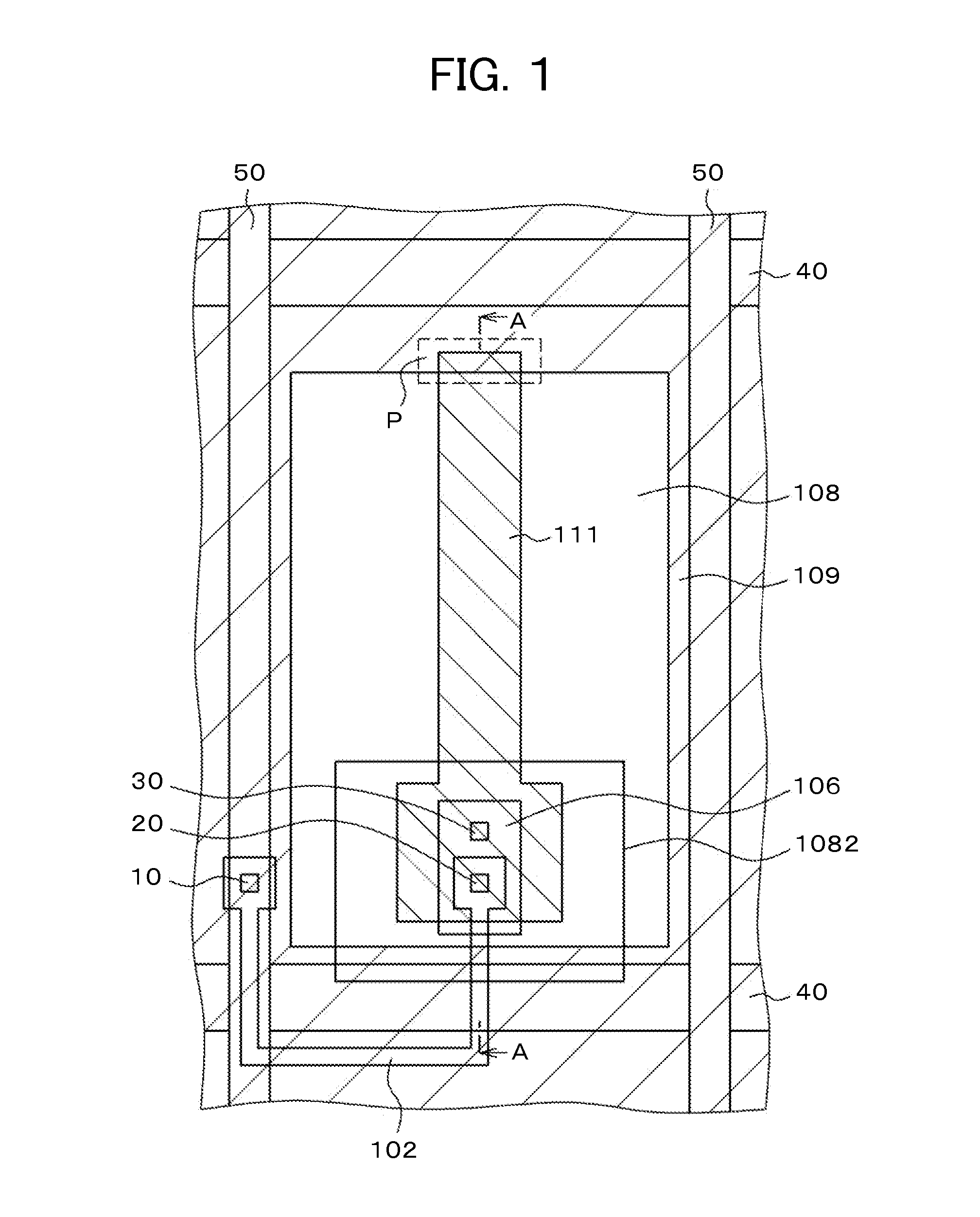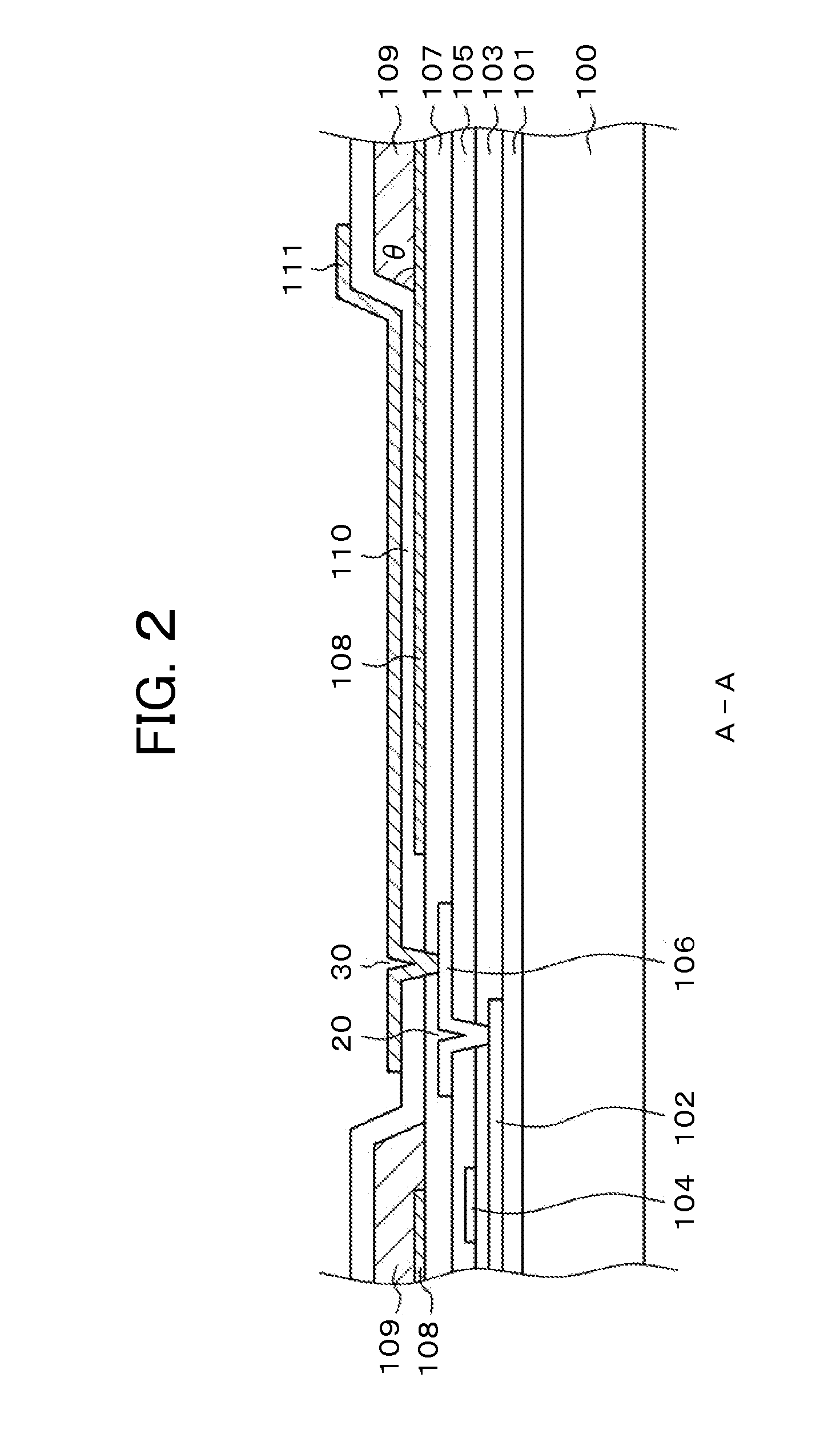Liquid crystal display device
a liquid crystal display and display device technology, applied in non-linear optics, instruments, optics, etc., can solve problems such as problems such as viewing angle properties, and achieve the effects of preventing the occurrence of domains, excellent contrast, and high definition
- Summary
- Abstract
- Description
- Claims
- Application Information
AI Technical Summary
Benefits of technology
Problems solved by technology
Method used
Image
Examples
first embodiment
[0041]FIG. 1 is a plan view of a pixel structure according to a first embodiment. FIG. 2 is a cross-sectional view taken along line A-A of FIG. 1. FIG. 1 is the same as FIG. 11 in which the semiconductor layer 102 is formed of poly-Si between the video signal lines 50 and the source electrode 106, a first TFT is formed using the scanning line 40 as a gate electrode on the left side below the video signal line 50, and a second TFT is formed and connected to the first TFT in series. The region of the semiconductor layer 102 below the scanning line 40 is a channel portion, and the other region is doped with impurities to form a conductor. The video signal line 50 is connected to the first TFT through the first through hole 10. Then, the source electrode 106 is connected to the second TFT through the second through hole 20.
[0042]The pixel electrode 111 is connected to the source electrode 106 through the third through hole 30. In the present embodiment, the pixel electrode 111 has a lon...
second embodiment
[0051]FIG. 5 is a plan view of the pixel portion, which shows a second embodiment of the present invention. FIG. 6 is a cross-sectional view taken along line B-B of FIG. 5. The present embodiment is different from the first embodiment in that the first electrode formed flat on the lower layer is used as the pixel electrode 111, and that the second electrode on the upper layer with the second interlayer insulating film 110 therebetween is used as the counter electrode 108 with a slit 1081.
[0052]FIG. 5 is the same as the first embodiment in which the organic passivation film 109 is removed in the pixel surrounded by the scanning lines 40 and the video signal lines 50, except the periphery of the pixel. In FIG. 5, the pixel electrode 111 marked by diagonal lines is formed flat in the pixel. The peripheral portion of the counter electrode 108 rides over the organic passivation film 109 marked by diagonal lines, which is formed in the vicinity of the pixel. In FIG. 5, the source portion ...
third embodiment
[0058]FIG. 7 is a plan view of a third embodiment of the present invention. FIG. 8 is a cross-sectional view taken along line C-C of FIG. 7. The third embodiment is different from the second embodiment in that the inorganic passivation film 107 shown in FIG. 6 of the second embodiment is not present, and that the pixel electrode 111 and the source electrode 106 are formed on the same first interlayer insulating film 105. Thus, the third through hole is not present in FIGS. 7 and 8. The source electrode 106 and a portion of the pixel electrode 111 overlap to establish electrical conductivity. The other structures are the same as the second embodiment.
[0059]In other words, in FIG. 7, the organic passivation film 109 marked by diagonal lines is present in the vicinity of the rectangular pixel electrode 111 marked by diagonal lines. Then, the counter electrode 108 with the slit 1081 covers the entire electrode. FIG. 8 is a cross-sectional view taken along line C-C of FIG. 7. FIG. 8 is t...
PUM
| Property | Measurement | Unit |
|---|---|---|
| thickness | aaaaa | aaaaa |
| inclination angle | aaaaa | aaaaa |
| insulating | aaaaa | aaaaa |
Abstract
Description
Claims
Application Information
 Login to View More
Login to View More - R&D
- Intellectual Property
- Life Sciences
- Materials
- Tech Scout
- Unparalleled Data Quality
- Higher Quality Content
- 60% Fewer Hallucinations
Browse by: Latest US Patents, China's latest patents, Technical Efficacy Thesaurus, Application Domain, Technology Topic, Popular Technical Reports.
© 2025 PatSnap. All rights reserved.Legal|Privacy policy|Modern Slavery Act Transparency Statement|Sitemap|About US| Contact US: help@patsnap.com



